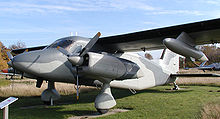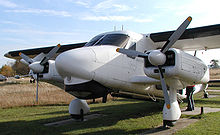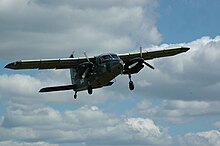Dornier Thursday 28
With Dornier Do 28 two different twin-engine were STOL - multipurpose aircraft of the German manufacturer Dornier referred. They were mainly used militarily in the German Bundeswehr and in other armed forces. The Do 28 A / B (1959) and the Do 28 D Skyservant (1966) models were produced.
Dornier Do 28 A / B
The twin-engine Do 28 was developed from the single-engine Do 27 at the end of the 1950s. In the Do 28, designed as a cantilever high- wing aircraft, the wings and the buoyancy aids of the Do 27 were taken over together with the rear fuselage part of the cabin for six people and the control surfaces. The two Lycoming engines and the two struts of the streamlined main landing gear were attached to a lower wing. Like the Do 27, the Do 28 was characterized by a high cruising speed, excellent slow flight characteristics and very short take-off and landing distances from unpaved areas. The first flight of the Do 28 A with two 255 HP Lycoming O-540 engines and two-blade propellers took place on March 20, 1960 in Oberpfaffenhofen .
The Do 28 B had two 290 hp Lycoming IO-540 engines and three-blade adjustable propellers.
With the designation Do 28 C, an eight-seat version with two 530 WPS propeller turbines was still in development, but this was not implemented.
A total of 120 machines of the type Do 28 A / B were built, samples of which are still in use today in Africa and South America.
Dornier Do 28 D Skyservant
Although the designation Do 28 D suggests this, it is not a variant of the first Do-28 series. The aircraft has only roughly the outer shape and the wing construction in common with the Do 28 A and Do 28 B. It was completely redesigned with rectangular cross-sections of the fuselage and engine pods. The aim was to create a robust, easy-to-load and easy-to-repair aircraft for use under difficult conditions. 121 Dornier Do 28 D-2 Skyservant were built between 1971 and 1974 in Oberpfaffenhofen for the German armed forces and were mainly used as transport and liaison aircraft until the Do 228 -LT was introduced (1994) . 20 machines of this series were handed over to the Navy , ten from 1978 also served for sea surveillance and were therefore provided with containers for additional fuel on the wings (see photo). The strong noise development, which was increasingly out of date, was perceived as annoying. Therefore there was also a further development of the Do 128 -6 with a much quieter turbine drive. An aircraft of this type was equipped with the “New Technology Wing” (TNT) as a test vehicle for the Do 228.
Between the commissioning, retirement and sale of most of the machines, there were only three accidents in the 20 years, two of the Air Force and one of the Navy were lost.
The aircraft type was flown in 30 countries and partly still flies there today. More than 150 pieces were built.
The crew consisted of two pilots, up to twelve passengers could be taken.
In the Bundeswehr jargon , the Do 28 was somewhat disrespectfully referred to as the “Bauernadler”, but it was very popular as a reliable “workhorse”. In addition to transport versions, Turkey also received two specially equipped SIGINT aircraft with the code name Anadolou.
Currently, only the two Do-28-D2 copies of the RK Flugdienst are still in their original airworthy condition with German approval and are regularly operated for reservist work from the Uetersen airfield in western Hamburg. The RK Flugdienst machine, approved as D-ICDY (ex 58 + 89), was in service until the 1990s as a lecture hall version for training in practical flight navigation. The second Skyservant D-IRES (ex 59 + 11) last served as a transport and liaison aircraft with the Naval Aviation Wing 5 in Kiel Holtenau.
Dornier Do 28 D-2 OU Skyservant "Oil-Do"
The Dornier Do 28 D-2 OU Skyservant , shown here in white on the photos, was the oil monitoring aircraft of the Marinefliegergeschwader 5. In 1984 and 1985, with funds from the Federal Ministry of Transport, two machines (59 + 19, 59 + 25) were converted to operate in the North and Tracking down polluters in the Baltic Sea. The machines called “Oil-Do” by naval aviators differ from the normal model in that they have an elongated side-view radar ( SLAR ) antenna placed in the middle of the fuselage and the black radome under the cockpit. In 1991 both Dos flew for a few weeks after the end of the Second Gulf War from Bahrain with various missions in the Persian Gulf. In September the two oil Dosers together with a Do 228 LM (57 + 01) were given to the Naval Aviation Squadron 3 "Graf Zeppelin" and at the end of 1995 they were replaced by the successor model Dornier Do 228 LM .
From the oil Dos (Do 28 and Do 228), over 18,000 flight hours from the beginning of the surveillance flights in 1986 to September 2002, 2900 marine pollution could be registered and 300 polluters identified.
One of these machines (59 + 19) is exhibited in the Aeronauticum in Nordholz .
Dornier Do 28 G.92
Based on the D version, the Hungarian Andreas Gál developed a version powered by two Czech turbine engines in 1997 , which was intended to be used for dropping parachutists . The aim was to build a robust, fast-rising aircraft that was optimally geared to the needs of the landfall operation. For this purpose, the Slovakian Aerotech Slovakia replaced the standard built-in piston engines in seven original D-2 machines, made modifications to the electrical system and de-icing system, and installed alternative propellers and a jumper equipment with roller door, wind deflectors and grab handles. The Hungarian aviation authority CAA approved the G.92 in March 1997. An application for approval within the JAA states was submitted to the Federal Aviation Office in 2007 . In 2008, three planes flew in Europe, all with Hungarian registration, among others in Soest and Wiener Neustadt . In 2009 the Wiener Neustädter machine (until then HA-ACM) was registered as the first G.92 with German approval under the label D-IEDO. The aircraft stationed in Soest (more precisely Soest / Bad Sassendorf airfield) is now (as of 08/2014) marked with the D-IMOB (previously HA-ACZ). The machine with the registration D-IEDO was sold to Skydive Hibaldstow, England in February 2015 and has been in use at Portimão Airport since then .
Military users
Israel Defense Forces
The Israeli Air Force put the Do 28 B-1 model into service from 1971. A total of 12 to 26 units were procured on the civil aircraft market. The aircraft were nicknamed Agur (crane). They were retired in 2001, but returned to service in 2003. The exact number of aircraft still in use is unknown.
Technical specifications
| Parameter | Thu 28 A | Thu 28 B | Thu 28 D-2 OU Skyservant | Thu 28 G.92 |
|---|---|---|---|---|
| crew | 2 | 3 | 1 pilot | |
| Passengers | 4th | 15 parachutists | ||
| length | 9.2 m | 9 m | 11.41 m | |
| span | 13.8 m | 15.55 m | ||
| height | 2.8 m | 3.90 m | ||
| Total mass | 2450 kg | 2670 kg | 4150 kg | |
| drive | 2 × six-cylinder piston engine | 2 × propeller turbine | ||
| Drive type | Lycoming O-540 | Lycoming IO-540 | Lycoming IGSO-540-A1E | Walter M601-D2 |
| Drive power | 2 × 255 PS (188 kW) | 2 × 290 PS (213 kW) | 2 × 380 PS (279 kW) | 2 × 450 PS (331 kW) |
| Top speed | 280 km / h | 302 km / h | 320 km / h | |
| Service ceiling | 5900 m | 6300 m | 7680 m | 4000 m in landing mode without oxygen supply Circulation time approx. 18 min (of which approx. 11 min for the climb) |
| Normal range | 1115 km | 1780 km | 2965 km | approx. 700 km |
See also
Web links
- Type Certificate of the DO-28 Series - EASA-TCDS-A.360 (PDF; 2.68 MB)
- Bundeswehr Classix: Duty man in flight (1971) ( YouTube video)
Individual evidence
- ↑ DO28 flight charter. Retrieved June 27, 2020 .
- ↑ own observation / photo
- ^ Israeli Air Force - Aircraft Types. Retrieved June 27, 2020 (English).
- ^ Israeli Air Force Museum - Hatzerim Air Force Base - Israel. Retrieved June 27, 2020 (English).










